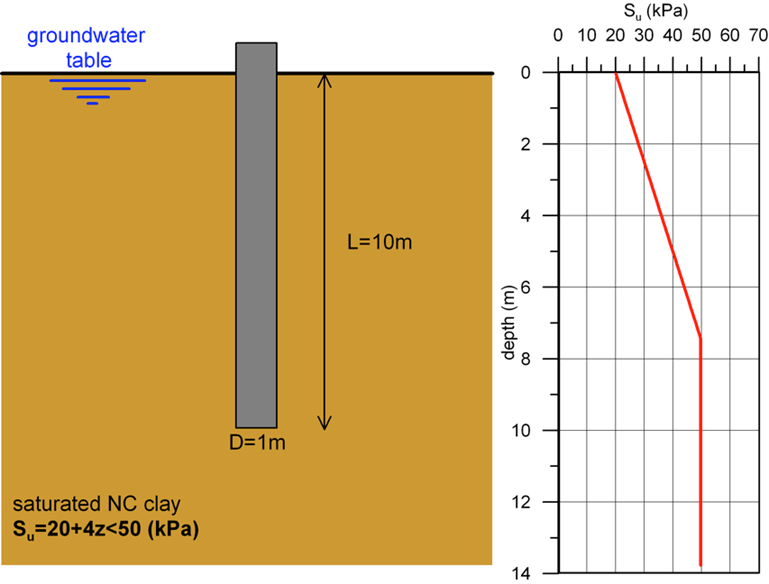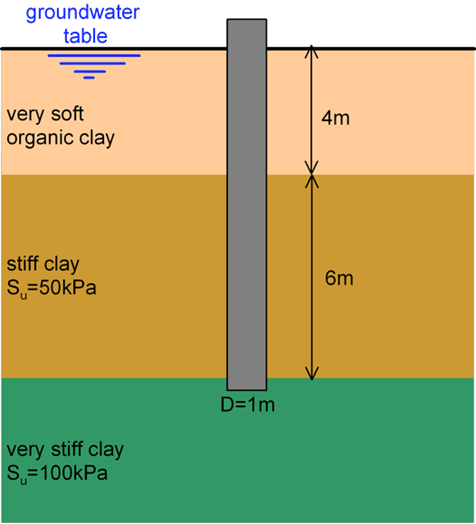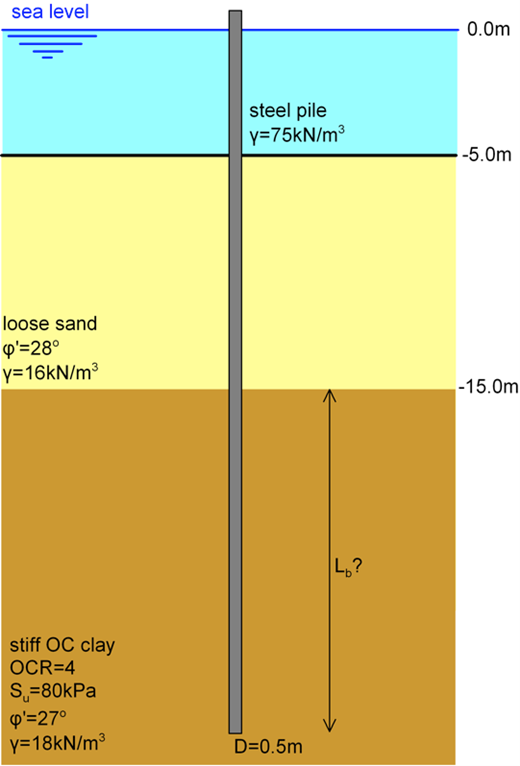6.30 Additional problems
6.30.1
Determine the short-term design bearing capacity of the pile shown below, according to AS2159, assuming the basic geotechnical strength reduction factor to be φgb = 0.5.

Answer:
φgbQf = 731 kN
6.30.2
Determine the short-term design bearing capacity of the pile shown below, embedded in a multi-layered clay formation. Assume that the surficial very soft organic clay layer does not contribute to the skin friction resistance of the pile. Follow AS2159 provisions, and consider the basic geotechnical strength reduction factor to be φgb = 0.5.

Answer:
φgbQf = 542 kN
6.30.3
A shallow-water offshore structure is going to be founded on driven steel pipe piles. The geotechnical profile of the area consists of loose sand, underlain by a practically infinitely deep layer of stiff over-consolidated clay. According to the Structural Engineer, the design compressive load on each pile is 800 kN (including the weight of the pile), and the design tensile load is 500 kN.
Determine the necessary embedment depth of the piles Lb, assuming the basic geotechnical strength reduction factor to be φgb = 0.5. To account for disturbance of the sand during pile driving works, as well as possible scour, ignore the top 3 m of the sand layer when calculating the friction resistance of the pile.
Additional information:
- Interface friction angle for steel piles φi = 0.5φ′
- Reduction factor for uplift resistance of piles ψt = 0.75

Answer:
Lb = 18.5 m
6.30.4
A pre-stressed concrete pile with diameter D = 1 m and Young’s modulus Ep = 30 GPa is driven into a uniform layer of soft-to-medium clay, with undrained Young’s modulus Eu = 3 MPa.
- Determine the necessary pile length so that the settlement under the working load Qw = 1 MN is less than the allowable settlement ρD = 0.03 m.
- An alternative nearby location is examined for the project, where a very stiff clay layer with Eu = 30 MPa is encountered at a depth of -10 m. If the pile is embedded in the stiff layer (L ≈ 10 m), will the settlement criterion be satisfied?
- Assuming that the alternative location is selected, how many piles must be used to carry a working group load of Qw,group = 4 MN while still satisfying the settlement criterion?
Note: The settlement factor Is involved in the estimation of the immediate settlement of friction piles can be obtained for this particular problem as Ιs = 0.618(L/D)-0.652.
Answer:
- 19.2m
- Yes
- 6 piles
6.30.5
A cylindrical steel pipe pile of external diameter Dext = 0.3 m, wall thickness t = 0.005 m and design yield strength σy = 450 MPa, is driven through a uniform layer of medium-dense sand with friction angle φ′ = 33º and unit weight γ = 18 kN/m3. The necessary pile length to carry the vertical load is L = 5 m. Assuming the pile is connected to a rigid cap (fixed-head), determine its collapse lateral load.
Note: Do not apply a geotechnical strength reduction factor on the collapse load.
Answer:
Hf = 211.7 kN
6.30.6
A cylindrical pipe pile made of steel with yield strength σy = 450 MPa and featuring wall thickness t = 0.01 m is driven through a uniform clay layer with undrained shear strength Su = 60 kPa. Assuming the pile is connected with a rigid cap (fixed-head), and “long pile” failure mode, determine the necessary external pile diameter so that its collapse lateral load is Hf = 300 kN.
Note: Do not apply a geotechnical strength reduction factor on the collapse load.
Answer:
Dext = 0.235 m

